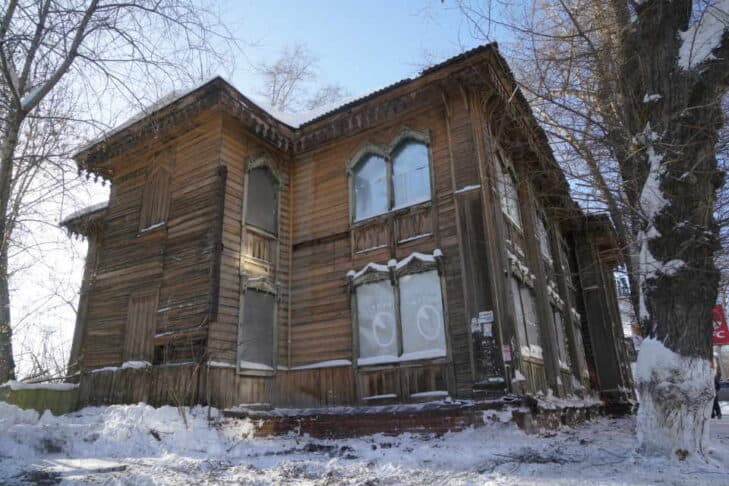Many recruits were boys, some as young as 12, whisked away and sometimes abducted to military boarding homes where they trained as soldiers and then served as long as 25 years. It was considered one of the worst calamities that ever befell the Russian Jewish community, with approximately 75,000 Jews conscripted until 1856, when reforms were finally implemented.
After completing their service, a small group of Jews settled in the Siberian town of Tomsk, where, in 1907, they built a wooden temple that became known as the Soldiers’ Synagogue. With three domes, neo-Moorish flourishes and an exterior door shaped like a Torah scroll, it is a testament to the faith and perseverance of the Russian Jewish community in the face of trauma and oppression.
Michael Mail, who holds a master’s degree from Brandeis University, is working to save it from ruin. For decades, the Soldiers’ Synagogue has languished in disrepair and was once even used as a homeless shelter. Many of its windows are now boarded up, and its floor is falling apart.
Mail’s organization, the London-based Foundation for Jewish Heritage, exists to preserve Jewish architectural sites, monuments and places of cultural significance at risk worldwide.
“We have to save these buildings,” he said. “They are often the last testimony to Jewish life in these places.”
The Foundation, which started in 2015 with Mail as chief executive, has created an inventory of over 3,300 historic Jewish sites, many in urgent need of restoration. Among them are:
- Merthyr Tydfil Synagogue in Wales (1870s)
Built in the Gothic Revival style, it served the town’s small community of Jewish merchants and traders who moved there from Eastern Europe to take advantage of the opportunities afforded by the region’s growing coal industry. With support from the Foundation, it’s now scheduled to open in several years as a Jewish heritage center.
- Meir Tweig Synagogue in Baghdad (1942)
The Iraqi capital’s Jewish community is now so small that there’s not even enough for a minyan (quorum of 10 men) to keep this synagogue operational, but the building is still habitable, though the walls and ceiling are crumbling and the brick facade is cracking. In a 2020 report, the Foundation identified the temple as a top Jewish site in Iraq and Syria needing stabilization work.
- Orla Synagogue in Poland (second half of the 17th century)
Orla was a thriving center of Jewish life until 1942, when the Jews were deported to a Nazi extermination camp. German soldiers warehoused the property they stole from the town’s Jews in the synagogue and destroyed the ark. The building has barely been maintained since World War II. The interior, with baroque and Renaissance flourishes and painted with colorful frescoes, is badly deteriorating.
Pursuing His Passion
Mail grew up in Glasgow, Scotland, where the Jewish community was small but tight-knit. He went to law school, but a trip to Israel convinced him to alter his career plans and focus on Jewish life. His time studying at Brandeis University’s Hornstein Jewish Professional Leadership Program “opened my eyes,” he said. “I realized I could have a career in something that was my passion.”
After graduating, he moved to London and took on various positions at Jewish organizations, including working with the late Jonathan Sacks, then the United Kingdom’s chief rabbi.
Mail also published three novels, including “Exposure,” about a young photography student’s relationship with a charismatic but dangerous Holocaust survivor living in London’s East End.
Cemeteries, Synagogues and More
The Foundation recently partnered with the European Jewish Cemeteries Initiative (ESJF) to identify and document more than 1,700 Jewish burial sites in Central and Eastern Europe. A 2021 report concluded that “hundreds of cemeteries [are] in urgent need of protection, many running the risk of disappearing altogether.”
In many cases, there are no longer Jews living near the synagogues, cemeteries or other Jewish historical structures at risk of perishing. In these cases, Mail said, the Foundation works to engage with and mobilize the local communities in the preservation effort.
“These buildings can be a vehicle for educating the local populations about who the Jews once were,” he said, “combating ignorance and prejudice and building empathy and understanding.”
Another major project for the Foundation is restoring and preserving the medieval synagogue of Híjar in northern Spain. It was built in the early 15th century and is currently owned by the Catholic Church. It is in a state of disrepair, though, because it’s not the Church’s main house of worship in the town and is used only once a year.
In May, the European Union announced a half-million dollar grant to rehabilitate the Jewish quarter’s houses, streets and urban infrastructure surrounding the synagogue.
Mail currently raises several hundred thousand dollars annually to fund the Foundation’s budget but hopes to grow the organization into a multi-million dollar operation.
“We have the opportunity to rescue so many of these structures,” he said, “but it’s a race against time.”
This article originally appeared on The Jewish Experience, Brandeis University’s website devoted to Jewish issues. Subscribe to the monthly newsletter.
This post has been contributed by a third party. The opinions, facts and any media content are presented solely by the author, and JewishBoston assumes no responsibility for them. Want to add your voice to the conversation? Publish your own post here. MORE



